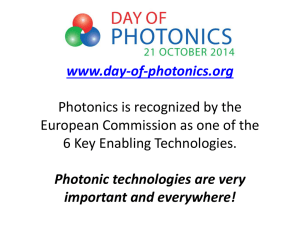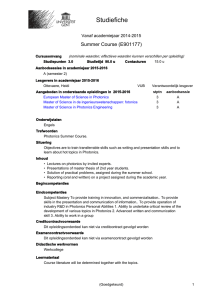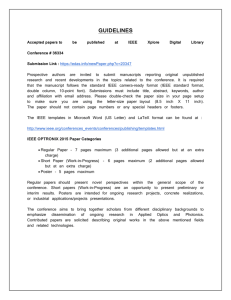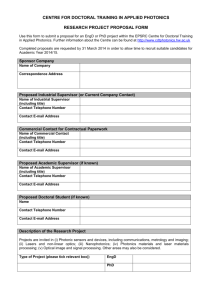Optics and Photonics: Essential Technologies for Our Nation
advertisement
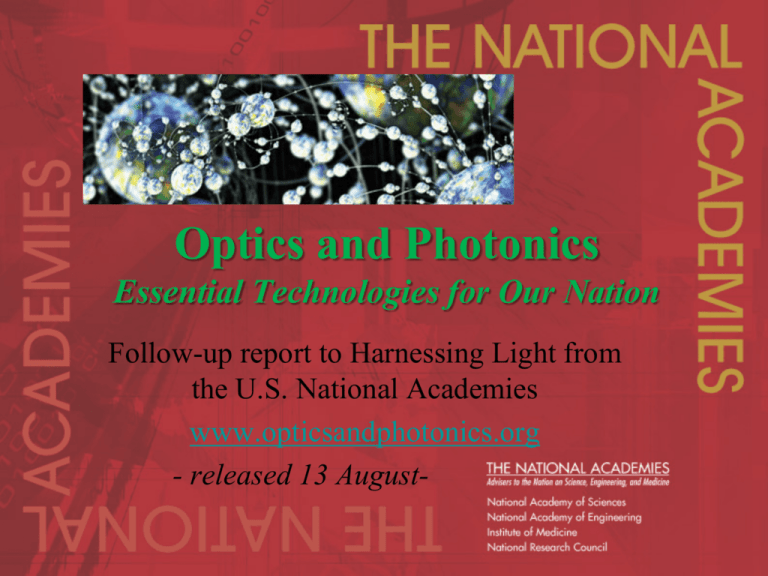
Optics and Photonics Essential Technologies for Our Nation Follow-up report to Harnessing Light from the U.S. National Academies www.opticsandphotonics.org - released 13 August- 1. Review updates in the state of the science that have taken place since publication of Harnessing Light 2. Identify the technological opportunities that have arisen from recent advances in, and potential applications of, optical science and engineering; 3. Assess the current state of optical science and engineering in the United States and abroad, including trends in private and public research, market needs, examples of translating progress in photonics innovation into competitiveness advantage (including activities by small businesses), workforce needs, manufacturing infrastructure, and the impact of photonics on the national economy; 4. Prioritize a set of research grand-challenge questions to fill identified technological gaps in pursuit of national needs and national competitiveness 5. Recommend actions for the development and maintenance of global leadership in the photonics driven industry --including both near-term and long-range goals, likely participants, and responsible agents of change. 2 • AFOSR • Army Research Office (ARO) • Defense Advanced Research Projects Agency (DARPA) (DSO and MTO) • Department of Energy (DOE) (BES and EERE) • National Institute of Standards and Technology (NIST) • National Science Foundation (NSF) • OSA • SPIE 3 • Dr. Paul McManamon (Co-chair) • Dr. Alan Willner (Co-chair) • Dr. Rod Alferness • Dr. Thomas Baer • Dr. Joe Buck • Dr. Milton Chang • Dr. Connie Chang-Hasnain • Dr. Charles Falco • • • • • • • • • Dr. Erica Fuchs Dr. Waguih Ishak Dr. Prem Kumar Dr. David A.B. Miller Dr. Duncan Moore Dr. David Mowery Dr. N. Darius Sankey Mr. Edward White Dr. Erik Svedberg (National Academy Staff Lead) Motivation for Study • The science and engineering of light has enabled dramatic technical advances. • Globalization of manufacturing and innovation has accelerated. • Optics and photonics have become established as enabling technologies for a multitude of industries that are vital to our nation’s future. 5 Fun fact: roughly 12 of the 50 best inventions of 2011 listed by Time Magazine had optics as a key technological part of the invention. Challenges • The field of optics and photonics is extremely broad in terms of the technical science and engineering topics that it encompasses. • The field impacts many different market segments, such as energy, medicine, defense, and communications, but as an enabling technology it is not always highlighted in available data about these areas. • The field has expanded greatly beyond the United States, such that many other countries have invested heavily in research and development and manufacturing. It was challenging to gather data specific to optics and photonics in terms of workforce and economic impact. 6 Overarching Goals •Although many of the innovations in optics and photonics have occurred in the United States, U.S. leadership is far from secure. •The committee heard compelling arguments that, if the United States does not act with strategic vision, future scientific advances and economic benefits might be led by others. •The study should help policy makers and leaders decide on courses of action that can: advance the future of optics and photonics. promote a greener, healthier, and more productive society. 7 ensure a leadership position for the United States in the face of increasing foreign competition. Study Outline Chapter # 8 Chapter Title Chapter 1 Introduction Chapter 2 Impact of Photonics on the National Economy Chapter 3 Communications, Information Processing & Data Storage Chapter 4 Defense and National Security Chapter 5 Energy Chapter 6 Health and Medicine Chapter 7 Advanced Manufacturing Chapter 8 Advanced Photonic Measurements & Applications Chapter 9 Strategic Materials for Optics Chapter 10 Displays The Study has “layers” There are many “hooks” in the report that can be used for supporting future activities many aspects of optics and photonics. 9 Example Grand Challenges • Develop a seamless integration of photonics and electronics components, as a mainstream platform for low cost fabrication and packaging of systems on a chip for communications, sensing, medical, energy & defense. • Develop military platforms capable of wide area surveillance, exquisite object identification, high-bandwidth free-space communication, laser strike, and defense against missiles. • Develop optical sources & imaging tools, to support an order of magnitude increased resolution in manufacturing. • Invent technologies for the next factor of 100 cost-effective capacity increases in our optical networks. 10 Impact on the National Economy (I) • Key Finding: Photonics is a key enabling technology with broad applications in numerous sectors of the U.S. economy • Key Finding: Data on photonics industry output, employment, and firm-financed R&D investment are not currently reported by U.S. government statistical agencies • Finding: A significant gap in the economic data on photonics is a lack of systematic collection or reporting by the federal government of its significant investment in photonics R&D. • Finding: The private organizations that monitor U.S. venture capital investment trends also do not collect information on the full spectrum of photonics-related venture capital investments. • Finding: Many of the important early U.S. innovations in photonics relied on R&D performed in large industrial laboratories and benefited as well from defense-related R&D and procurement spending. 11 National Photonics Initiative • Key Recommendation: The committee recommends the federal government develop an integrated initiative in photonics – A NPI would identify critical technical priorities for long-term federal R&D funding, offer a basis for coordinating federal spending across agencies – A NPI could provide matching funds for industry-led research consortia (users, producers, material and equipment suppliers) focused on specific applications • Key Recommendation: The committee recommends that the proposed NPI spearhead a collaborative effort to improve the collection and reporting of R&D and economic data on the optics and photonics sector 12 Example Recommendations (I) • Position the U.S. as a leader for the global data center business. • Develop a plan for cost parity across the country’s electrical grid for solar power versus new fossil fuel powered electric plants by the year 2020. • Develop new instrumentation to allow simultaneous measurement of all immune system cell types in a blood sample. • New approaches in existing methods and instruments, should be developed to increase the rate at which new pharmaceuticals can be safely developed and proved effective. 13 Example Recommendations (II) • Generate light whose photonic structure has been pre- arranged to yield better performance than possible with ordinary lasers. •Small U.S. companies should be encouraged, and supported, to address market opportunities for applying research advances to niche markets while exploiting high-volume consumer components. •The U.S. should aggressively develop additive manufacturing technology and implementation. 14 Example “Findings” & “Conclusions” • Communications networks and information processing consume a relatively small fraction of the global energy budget (~2 percent), but this percentage will grow significantly unless action is taken. • To enable the U.S. to be productive in manufacturing photonics goods, a capable and fully trained workforce must exist at all levels, including shop floor associates, technicians, and engineers. • There are potential workforce shortages for the United States in the areas of science, technology, engineering, and mathematics in optics and photonics for defense and security. • The U.S. is losing first access and assured access to critical optics and photonics technologies at precisely the time that these capabilities are becoming a crucial defense technological advantage. 15 Importance of Education • Education plays a critically important role in ensuring a vibrant future in the fields of optics and photonics. • Many institutions outside the United States have invested heavily in excellent educational facilities. • The committee underscores the importance of maintaining a strong U.S. educational infrastructure in optics and photonics: training of skilled technicians ensuring that an adequate numbers of citizens can be hired by the defense industry increasing the quality of skilled blue-collar workers 16 Summary • Optics and photonics are critical enablers – Influence a significant fraction of the US economy. – Often people do not realize the impact of optics and photonics. – A NPI should be developed to synergistically plan this impact. • Accurate planning will require improved data • Many excellent opportunities for US technical leadership exist. – However, the US is being challenged for global leadership. 17 An Independent Viewpoint: Call to Action •Engage industry •Establish a photonics caucus (House) •Outreach to OSTP •Outreach to Federal agencies •State-level promotion •Data collection •Advocating by our community 18

